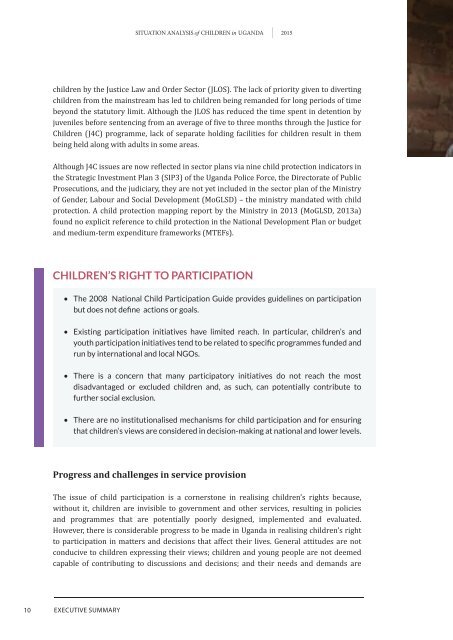Situation analySiS
1TNu802
1TNu802
You also want an ePaper? Increase the reach of your titles
YUMPU automatically turns print PDFs into web optimized ePapers that Google loves.
<strong>Situation</strong> <strong>analySiS</strong> of Children in uganda 2015children by the Justice Law and Order Sector (JLOS). The lack of priority given to divertingchildren from the mainstream has led to children being remanded for long periods of timebeyond the statutory limit. Although the JLOS has reduced the time spent in detention byjuveniles before sentencing from an average of five to three months through the Justice forChildren (J4C) programme, lack of separate holding facilities for children result in thembeing held along with adults in some areas.Although J4C issues are now reflected in sector plans via nine child protection indicators inthe Strategic Investment Plan 3 (SIP3) of the Uganda Police Force, the Directorate of PublicProsecutions, and the judiciary, they are not yet included in the sector plan of the Ministryof Gender, Labour and Social Development (MoGLSD) – the ministry mandated with childprotection. A child protection mapping report by the Ministry in 2013 (MoGLSD, 2013a)found no explicit reference to child protection in the National Development Plan or budgetand medium-term expenditure frameworks (MTEFs).CHILDREN’S RIGHT TO PARTICIPATION• The 2008 National Child Participation Guide provides guidelines on participationbut does not define actions or goals.• Existing participation initiatives have limited reach. In particular, children’s andyouth participation initiatives tend to be related to specific programmes funded andrun by international and local nGos.• There is a concern that many participatory initiatives do not reach the mostdisadvantaged or excluded children and, as such, can potentially contribute tofurther social exclusion.• There are no institutionalised mechanisms for child participation and for ensuringthat children’s views are considered in decision-making at national and lower levels.Progress and challenges in service provisionThe issue of child participation is a cornerstone in realising children’s rights because,without it, children are invisible to government and other services, resulting in policiesand programmes that are potentially poorly designed, implemented and evaluated.However, there is considerable progress to be made in Uganda in realising children’s rightto participation in matters and decisions that affect their lives. General attitudes are notconducive to children expressing their views; children and young people are not deemedcapable of contributing to discussions and decisions; and their needs and demands are10 ExECUtIvE SUMMary




